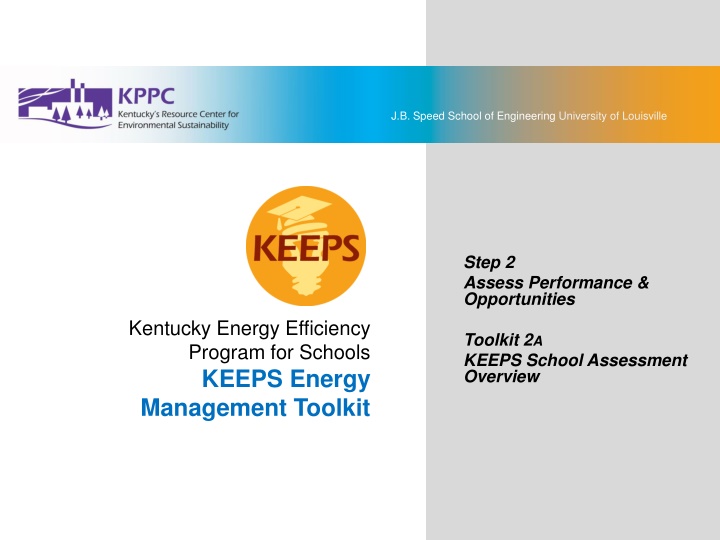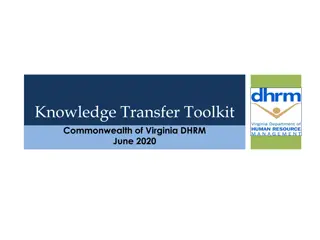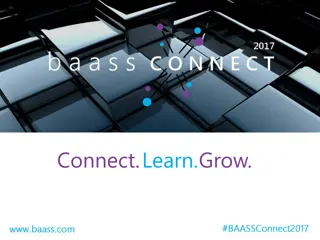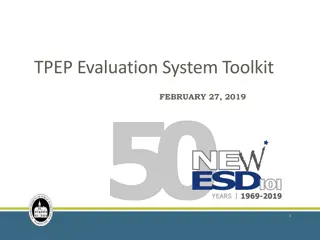Energy Management Toolkit for Schools
This toolkit provides a comprehensive guide for assessing energy performance and opportunities in schools. It includes steps such as making a commitment, setting goals, creating action plans, implementing them, evaluating progress, and recognizing achievements. The toolkit also outlines the roles of technical staff, offers assessment templates, and promotes energy efficiency in school environments.
Uploaded on Mar 11, 2025 | 0 Views
Download Presentation

Please find below an Image/Link to download the presentation.
The content on the website is provided AS IS for your information and personal use only. It may not be sold, licensed, or shared on other websites without obtaining consent from the author.If you encounter any issues during the download, it is possible that the publisher has removed the file from their server.
You are allowed to download the files provided on this website for personal or commercial use, subject to the condition that they are used lawfully. All files are the property of their respective owners.
The content on the website is provided AS IS for your information and personal use only. It may not be sold, licensed, or shared on other websites without obtaining consent from the author.
E N D
Presentation Transcript
J.B. Speed School of Engineering University of Louisville KEEPS Energy Management Toolkit Step 2: Assess Performance & Opportunities Toolkit 2A: KEEPS School Assessment Overview Step 2 Assess Performance & Opportunities Kentucky Energy Efficiency Program for Schools KEEPS Energy Management Toolkit Toolkit 2A KEEPS School Assessment Overview
KEEPS KEEPS Energy Management Toolkit Toolkit 2A KEEPS School Assessment Overview KEEPS Energy Management Toolkit Toolkit 2A: KEEPS School Assessment Overview 2 KPPC Kentucky s Resource Center for Environmental Sustainability
7-Step Energy Management Process 1. Make the Commitment 2. Assess Performance and Opportunities 3. Set Performance Goals 4. Create an Action Plan 5. Implement the Action Plan 6. Evaluate Progress 7. Recognize Achievements 3 KPPC Kentucky s Resource Center for Environmental Sustainability
KEEPS School Assessment Overview Introduction KEEPS Technical Staff Step 2 Tools School Assessment Process 4 KPPC Kentucky s Resource Center for Environmental Sustainability
KEEPS School Assessments Provide: A broad brush, cost-effective and time-effective look at energy usage and opportunities specifically for schools Consistent energy performance assessment methods Comparisons of school energy performance to norms for similar schools in similar use and similar climate A uniform energy assessment report template Recordkeeping to help identify performance progress with time 5 KPPC Kentucky s Resource Center for Environmental Sustainability
KEEPS Technical Staff Roles For districts without energy managers: Provides direct energy assessments Writes reports Provides field technical support Records, files and tracks assessment recommendations For districts with energy managers: Offers assessment training and assistance Provides field technical support Provides quality control review for assessment reports Records, files and tracks assessment recommendations 6 KPPC Kentucky s Resource Center for Environmental Sustainability
KEEPS Technical Team Territories Region 1: Giovanni Beltran Region 4: Ann Piechota Region 2: Bruce Hepke Region 5: Micah Johnson Region 3: Josh Tennen Region 6: Brian Atkinson 7 KPPC Kentucky s Resource Center for Environmental Sustainability
KEEPS Technical Staff Specialties Building Envelope Water Systems Lighting Utility Bill Analysis Operations/Maintenance Building Automated Systems Energy Profile Researches specific area of responsibility Disseminates latest relevant information Plug Load Thermostat Setback Energy Intensity Electrical Systems HVAC 8 KPPC Kentucky s Resource Center for Environmental Sustainability
KEEPS Assessment Tools 2A: KEEPS School Assessment Overview 2B: Utility Bill Analysis 2B1: KEEPS Utility Tracking Spreadsheet 2C: School Energy Profile 2D: Calculating Energy Use Intensity 2E: Evaluating School HVAC Systems 2E1: Thermostat Settings 2F: Lighting 9 KPPC Kentucky s Resource Center for Environmental Sustainability
KEEPS Assessment Tools (cont.) 2G: Plug Load 2H: Water Heating 2I: Water Conservation 2J: Building Envelope 2K: KEEPS Assessment Report Template 10 KPPC Kentucky s Resource Center for Environmental Sustainability
KEEPS Assessment Process 1. Start with Toolkit 2B: Utility Bill Analysis 2. Complete Toolkits 2C: School Energy Profile to 2J: Building Envelope 3. Write the assessment report with Toolkit 2K: KEEPS Assessment Report Template 11 KPPC Kentucky s Resource Center for Environmental Sustainability
KEEPS Assessment Process (cont.) 4. Review report with KEEPS Technical Staff in your region 5. Present report to school and school district personnel KEEPS will archive, consolidate and track recommendations and future implementation on statewide basis via yearly Energy Management Reports. 12 KPPC Kentucky s Resource Center for Environmental Sustainability
KEEPS Helpful Resources KEEPS Technical Staff and Regional Coordinators http://www.kppc.org/KEEPS Phone: Fax: Online: (502) 852-0965 (502) 852-0900 https://louisville.edu/kppc/form- mailers/keeps 13 KPPC Kentucky s Resource Center for Environmental Sustainability
J.B. Speed School of Engineering University of Louisville End of Prese ntatio n Kentucky Energy Efficiency Program for Schools (502) 852-0965 www.kppc.org/KEEPS KEEPS is funded by the American Recovery and Reinvestment Act through the combined efforts of the Kentucky Department for Energy Development and Independence, the U.S. Department of Energy and KPPC.























